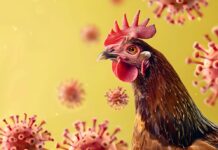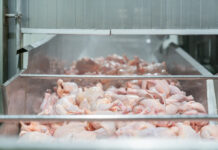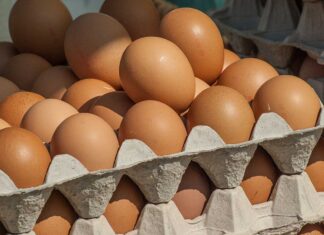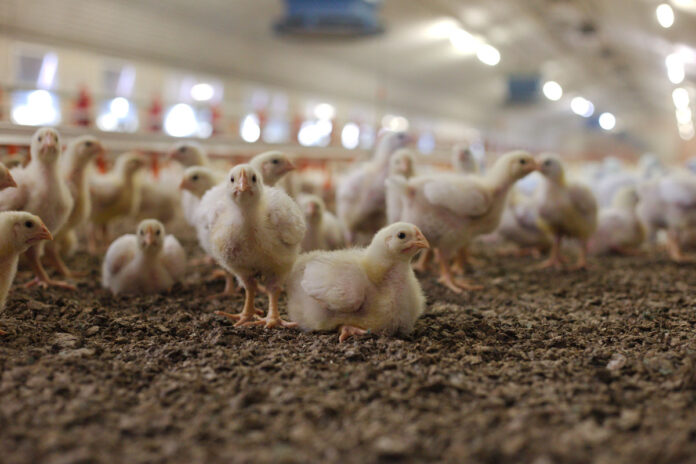
There are hardly any recent studies on the role of Oceania in the global meat industry. This article will focus on documenting the role of Australia and New Zealand in meat production in order to close the existing gap.
The continents of Asia, South America and Africa have been characterized by remarkable dynamics in the past decade, both in terms of population development and meat production. The author has presented detailed analyses of the three continents (Windhorst 2024, 2024a, 2024b). It is worth noting that there are hardly any recent studies on the role of Oceania in the global meat industry. This applies to both production and trade. The reasons for Oceania’s neglect can certainly be seen in its small share in the global population and economic value added on the one hand and its peripheral location on the other, which makes access to important sales markets difficult. Despite remarkable dynamics in some areas of animal production, the continent has lost shares in world meat production in the period under review. This article will focus on documenting the role of Australia and New Zealand in meat production in order to close the existing gap.
The limitations of the domestic market as an inhibiting factor
With 46.1 million inhabitants, Oceania accounted for 0.55% of the global population in 2023. The continent’s population is highly concentrated regionally (Table 1). Australia, with 26.4 million inhabitants, shared 57.3% in the continent’s total population, followed by Papua New Guinea with 10.5 million (22.4%) and New Zealand with 5.2 million (11.3%); the remaining independent countries of Micronesia, Melanesia and Polynesia contributed 2.8 million. Population density ranged from 2.2 inhabitants per km2 in Australia to 163 in Tonga. Both, the comparatively low population and the distance between the islands, are a problem because of the limited domestic demand for food and the high transportation costs, which reduce the competitiveness on the world market.
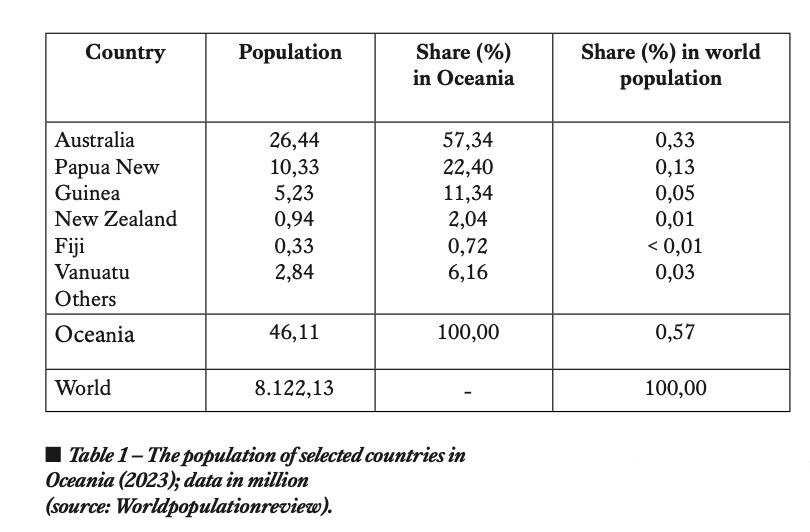 Remarkable momentum but share in global production declining
Remarkable momentum but share in global production declining
Between 2012 and 2022, meat production in Oceania increased from 6.0 million tons to 6.5 million tons or by 8.2% (Table 2). A look at the development of the most important meat types reveals major differences. The production volume of cattle meat decreased by 153,000 tons or 5.5% in the period under review. In contrast, production of the other meat types increased. Poultry meat in particular showed high absolute and relative growth rates. It accounted for 77.2% of the total growth in Oceania’s meat production. This reflects the red-white shift in global meat production and consumption, which can be observed (Windhorst 2021). The relative increase of 29.7% was almost identical with the value achieved at global level.
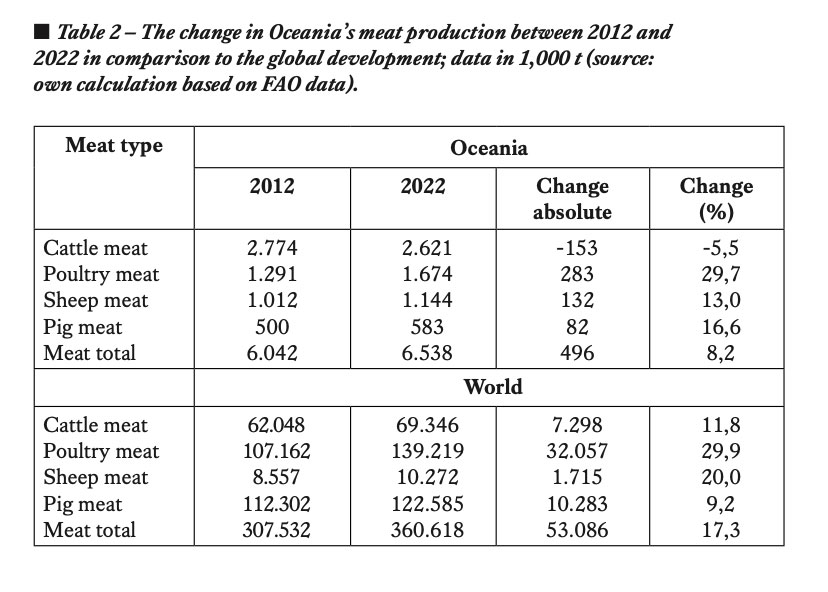 A comparison with the development of global production reveals that Oceania achieved a higher relative growth rate for pig meat, but a significantly lower for sheep meat. As will be shown in a later part of the article, this was mainly due to the decline in New Zealand’s production. Looking at the dynamics of meat production as a whole, a relative increase of 17.3% was achieved at the global level, more than twice as high as in Oceania. This considerable difference is also reflected in the decrease of the share in global meat production (Table 3). However, it is worth noting that the contribution to global meat production was three times as high as the continent’s share in the world population. This indicates a high export quota.
A comparison with the development of global production reveals that Oceania achieved a higher relative growth rate for pig meat, but a significantly lower for sheep meat. As will be shown in a later part of the article, this was mainly due to the decline in New Zealand’s production. Looking at the dynamics of meat production as a whole, a relative increase of 17.3% was achieved at the global level, more than twice as high as in Oceania. This considerable difference is also reflected in the decrease of the share in global meat production (Table 3). However, it is worth noting that the contribution to global meat production was three times as high as the continent’s share in the world population. This indicates a high export quota.
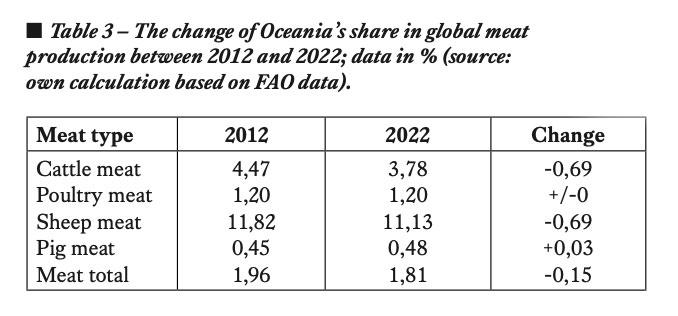 Different dynamics at country level
Different dynamics at country level
In a further step, the development of meat production at country level will be analysed. The countries of Micronesia, Melanesia and Polynesia are grouped together because they contributed only a small proportion to the continent’s total production. They will be dealt with as “island countries” in this article.
Between 2012 and 2022, cattle meat production in Australia fell from 2.2 million tons to 1.9 million tons or by 12.7%, while it grew from 607,000 tons to 728,000 tons or by 19.9% in New Zealand. Poultry meat, the second most important meat type, showed a remarkable dynamic. The production volume in Australia grew by 312,000 tons or 28.8%; in New Zealand, the absolute increase of 52,000 tons was significantly lower, however, a higher relative growth rate of 30.8% was achieved. In the island countries, beef production did not change in the decade analysed, stagnating at 15,000 t, which corresponds to a share of 0.6%. In contrast, poultry meat production rose from 37,000 tons to 56,000 tons or by 51.4%. A later section will document which countries were primarily responsible for this.
The development in the production of sheep meat and pork is interesting. Australia produced 153,000 tons more sheep meat in 2022 than in 2012, an increase of 27.6%. In New Zealand, in contrast, the production volume fell by 19,000 tons and only reached 437,000 tons, a decrease of 4.2%. Pig meat production developed similarly. In Australia, it rose by 84,000 tons to 436,000 tons or 23.9%. In New Zealand, it showed a downward trend, production declined from 51,000 tons to 45,000 tons or 11.8%.
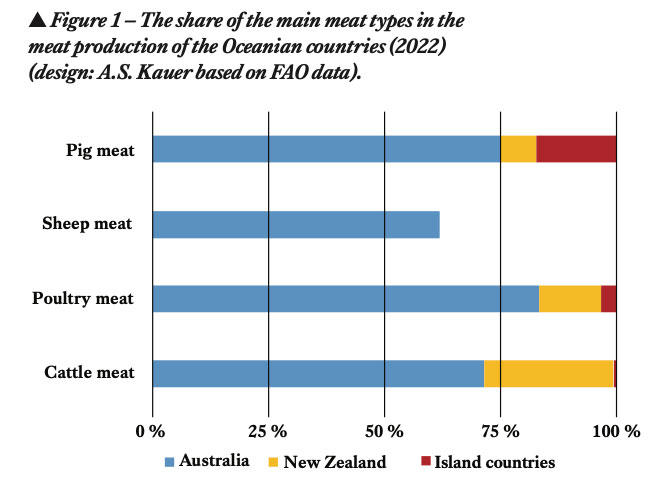 While the island countries produced almost no sheep meat, their production volume of pig meat increased from 97,000 tons to 102,000 tons or 5.2%. However, their share in Oceania’s pig meat production fell from 19.4% to 17.5% due to the dynamical development in Australia. The regional concentration of meat production in Oceania was very high, as can be seen in Figure 1. Australia accounted for 68.4% of total meat production in 2022, New Zealand 22.3% and the island countries 9.3%. As expected, Australia accounted for the highest share of all meat types. It was highest for poultry meat at 83.5% and lowest for sheep meat at 61.8%. New Zealand achieved the highest shares with 38.2% for sheep meat and the island countries with 17.5% for pig meat.
While the island countries produced almost no sheep meat, their production volume of pig meat increased from 97,000 tons to 102,000 tons or 5.2%. However, their share in Oceania’s pig meat production fell from 19.4% to 17.5% due to the dynamical development in Australia. The regional concentration of meat production in Oceania was very high, as can be seen in Figure 1. Australia accounted for 68.4% of total meat production in 2022, New Zealand 22.3% and the island countries 9.3%. As expected, Australia accounted for the highest share of all meat types. It was highest for poultry meat at 83.5% and lowest for sheep meat at 61.8%. New Zealand achieved the highest shares with 38.2% for sheep meat and the island countries with 17.5% for pig meat.
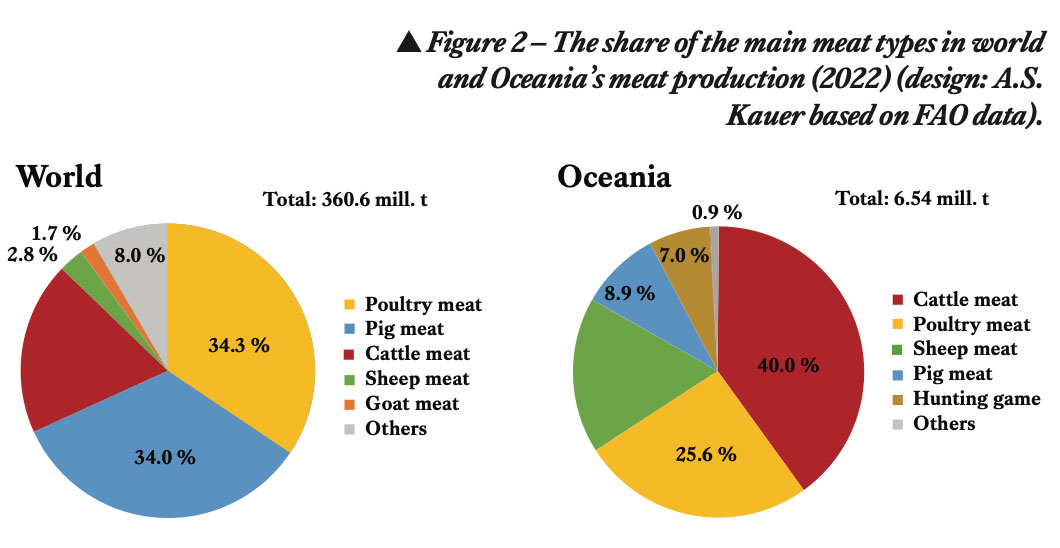 Major differences in the importance of meat types
Major differences in the importance of meat types
A comparison of the share of the meat types in overall meat production shows major differences as well between the continent’s and global production as between countries.
Figure 2 documents the share of the meat types in 2022 at the global level and in Oceania. While poultry meat ranked in first place in global production, followed closely by pig meat; in Oceania, cattle meat was in first place, well ahead of poultry meat. Pig meat was only in fourth place behind sheep meat. This reflects the availability of large natural grasslands on the one hand and the long affiliation to the British Commonwealth on the other.
Figure 3 documents the differences in the importance of the individual meat types in selected countries. In Australia and New Zealand, beef took the leading position. However, while poultry meat ranked ahead of sheep meat in Australia, sheep meat was in second place in New Zealand. Both countries dominated the list of sheep meat exporting countries in 2022. With a combined export volume of 833,000 tons, they accounted for over two thirds of the global export volume. The greater importance of poultry meat in Australia is due to the consumption behaviour of the population in the urban centers and the importance of tourism.
The distribution in Papua New Guinea, which had about twice the population of New Zealand, is interesting. With the exception of pig meat, commercial meat production was only of minor importance. In 2022, over 80% of the population’s meat demand was still determined by game meat. Vanuatu and Tonga are characteristic countries regarding the importance of pig meat, which accounted for well over half respectively almost three quarters of meat production, followed by beef. Both animal species were predominantly kept extensively, which also applied to backyard poultry farming.
In contrast, poultry meat was the unchallenged meat type in Fiji, sharing almost 85% in total meat production (Diarra 2017). This is mainly a result of the growing tourism. Due to the origin of visitors from countries with different religious affiliations, poultry meat is offered mainly in the tourist hotels because there is no ban on the consumption of this meat type.
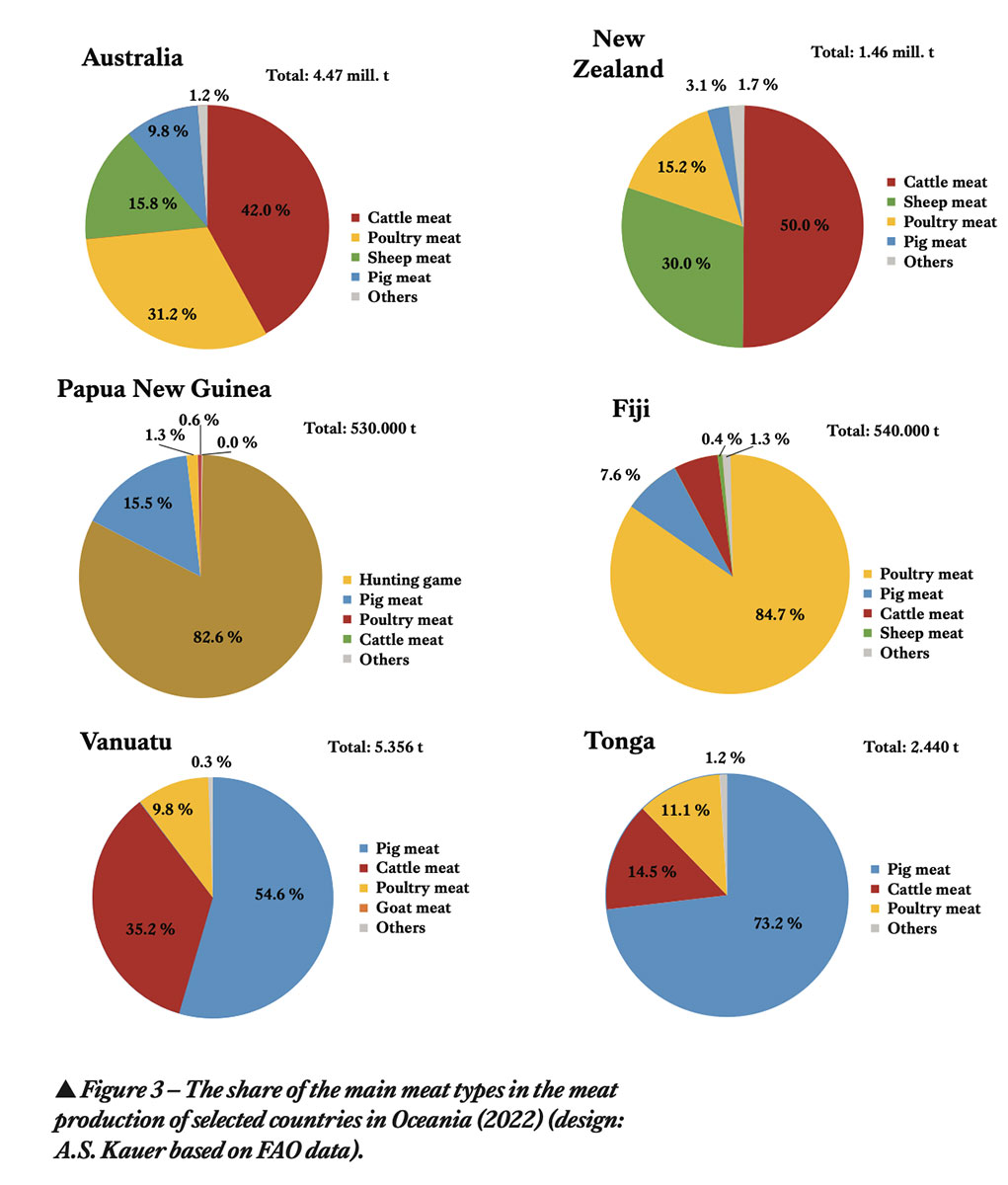 Summary and outlook
Summary and outlook
In the past decade Oceania occupied only a subordinate position in world meat production, with the exception of sheep meat. The small population, the peripheral location to the major world markets and the scattered location of the islands were the most important steering factors for the falling behind the global dynamics. Although cattle meat still held the leading position in the continent’s meat production, poultry meat showed by far the highest relative growth rate in the period under review. This reflected the global trend towards an increase in the production and consumption of white meat. On the global meat market, Australia and New Zealand achieved an undisputed leading role in the export of sheep meat. Trade with other meat types was only of minor importance.
It can be assumed that Oceania will lose further shares in global meat production in the current decade due to the low demand of the domestic market and its peripheral location to the most important meat importing countries. Poultry meat will be characterized by a very dynamical development in Oceania and will increase its share in the continent’s total meat production. In contrast, cattle meat production will further decline, simply due to the higher production costs and high retail prices. Sheep meat is likely to consolidate its position, mainly due to stable exports. Pig meat, which has been of comparatively minor importance, is unlikely to show high growth rates in the future, primarily due to the emerging trend in meat consumption in post-industrial societies.
Data sources and additional literature
Diarra, S.: Poultry industries in the South Pacific region: issues and future direction. In: World’s Poultry Science Journal 73 (2017), no. 2, p. 293-300.
Fisher, M. W. and B. S. Jones. “Australia and New Zealand.” Long distance transport and welfare of farm animals. Wallingford UK 2008, p. 324-354.
Windhorst, H.-W.: The red-white shift in global meat production: In: Zootecnica International 43 (2021), no. 5, p. 32-37.
Windhorst, H.-W.: Was it the decade of Asia? The dynamics of global meat and egg production between 2012 and 2022. In: Meatingpoint 2024, issue 54, p. 60 – 64.
Windhorst, H.-W.: South America – the continent of cattle and chickens. In: Meatingpoint 2024a, issue 55, p. 12-15.
Windhorst, H.-W.: Oceania – Losses in world meat production despite considerable momentum. In: Meatingpoint (in preparation)
Windhorst, H.-W.: Africa – supply problems despite remarkable dynamics. Part 1: Africa’s role in global meat and egg production. In: Fleischwirtschaft international (in preparation).
Windhorst, H.-W.: Africa – supply problems despite remarkable dynamics. Part 2: Production and supply at country level. In: Fleischwirtschaft international (forthcoming).
Worldpopulationreview: https://de.search.yahoo.com/yhs/search?hspart=trp&hsimp=yhs-005&type=Y149_F163_202167_012724&p=Worldpopulationreview.


